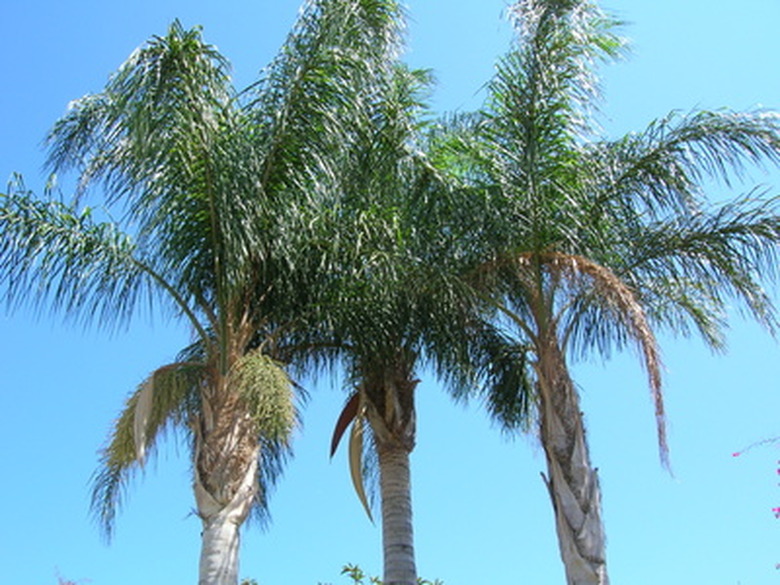Queen Palm Tree Diseases
Queen palm tree diseases are most often caused by fungal infections. It is important to remember that inappropriate care leaves queen palms more susceptible to fungal infections and can be a catalyst for illness and diminished health. Identify fungi that affect queen palms and exercise proper care for healthy trees.
Pink Rot
Queen palm tree diseases include the fungal infection called pink rot. Pink rot is caused by the fungus Gliocladium vermoeseni. Producing billions of spores on one palm tree alone, the University of California Cooperative Extension asserts that the fungus cannot be avoided; palms host pink rot and therefore it is ever-present. Though the the fungus is weak, its great number of spores can easily infect a queen palm if any wound or illness is present. Infected queen palms suffer from trunk rot. To prevent pink rot on your queen palm, keep the plant vigorous to avoid increased resistance. Apply the fungicide thiophanate-methyl to more established trees as a preventative measure; also, the fungicide T-methyl may help control an existing pink rot fungal infection.
- Queen palm tree diseases are most often caused by fungal infections.
- Though the the fungus is weak, its great number of spores can easily infect a queen palm if any wound or illness is present.
Improper Care
Though fungal infections make up the majority of diseases that affect queen palm trees, queen palms often become diseased simply due to improper care. Incorrect amounts of water or light, extreme temperatures, contact with damaging chemicals and incorrect pruning can cause disease, according to the University of California Cooperative Extension. Care-related disease is most prevalent in transplanted queen palms; when a queen palm is transplanted, the change in soil often leads to placement of the rootball in too much soil. The change in surrounding soil causes a breakdown of its components that release deadly gases, leading to the death of the queen palm. Also, excessive pruning of the queen palm may be fatal; when too many leaves are removed, photosynthesis (a plant's ability to convert sun energy into food used as its own fuel) becomes impossible and the tree starves to death. Employ proper care for healthy growth.
Ganoderma Butt Rot
Ganoderma butt rot is a fungal infection causing queen palm tree disease. Caused by the fungus Ganoderma zonatum, this malady leads to the rot and wood decay of the bottom 4 to 5 feet of the queen palm tree. Queen palms infected with this disease may display wilting, diminished vigor or the presence of conks (raised areas) on tree trunks. Conks release spores that infect queen palms by infesting surrounding soil. Ganoderma butt rott can occur on healthy trees or poorly maintained trees. No chemical control method is known at this time, according to the University of Florida IFAS Extension. To monitor your queen palm, remove and destroy conks to prevent the spread of disease. Remove the tree and its roots; though you may desire to replace the queen palm, ganoderma butt rot fungus lives in soil; the life of this fungus may be indefinite. Replace your queen palm with a different plant.
- Though fungal infections make up the majority of diseases that affect queen palm trees, queen palms often become diseased simply due to improper care.
- Care-related disease is most prevalent in transplanted queen palms; when a queen palm is transplanted, the change in soil often leads to placement of the rootball in too much soil.
